 web3.0
web3.0 Introduction to friend.tech: The new mechanism of friend.tech V2 has not met expectations, can you still invest?
Introduction to friend.tech: The new mechanism of friend.tech V2 has not met expectations, can you still invest?Introduction to friend.tech
friend.tech (FT) is one of the most successful Web3 dApps in SocialFi, reaching its highest revenue to net deposit ratio ever, with first month revenue exceeding 2 million US dollars, with net deposits exceeding US$33 million.
This should be a big week for FT as they launch V2 of the product and the platform’s token $FRIEND, introduce significant changes to enhance the sustainability and appeal of the protocol, and more, But that turned out to be (probably) the end of it.
Previously, some people were optimistic about these developments while others were pessimistic, but after today's developments, everyone is in disbelief.
In this article, we will take a deep dive into FT V2’s new mechanic, $FRIEND, explore any vulnerabilities it has experienced or is still experiencing, and discuss whether this business model is sustainable.
Let’s first look at the challenges faced by early versions of friend.tech.

On friend.tech V1
FT is the first to create sustained generation by aligning the interests of well-known cryptocurrency figures with those of retail investors Decentralized social application for revenue.
This consistency has resulted in FT becoming one of the new projects with the largest user base growth, increased activity, and increased revenue during the bear market.
However, this model is not sustainable due to the fees charged by the platform.
Although KOL and FT earn considerable income, retail investors are losing money every day. Since there is a 0% tax on buy and sell transactions, they can only make a profit by selling the keys at a price that is at least 20% higher than the purchase price.
This is only possible during periods of higher platform activity and inflows, which is the main reason for the volatile behavior observed in the chart below.

In the end, the cost became a barrier for many people to enter the market, causing FT V1 to make many people miserable.
Even so, FT V1 achieved several milestones within 6 months, which few protocols can achieve throughout its life cycle:
Generated approximately $13M in fees:

- ## Transaction volume reached $130M (probably SocialFi The highest transaction volume achieved by the dapp):

- ## Distributed approximately $6 million in revenue to its users:
 on friend.tech V2
on friend.tech V2
FT V2 released on Friday, March 3, 2024.
As part of this long-awaited update, users can finally claim their $FRIEND tokens.
However, the launch appears to have fallen short of expectations, including a lack of relevant information.
This is FT’s only official announcement on Twitter since its launch.
 #Understandably, this makes many people confused about the airdrop claiming process.
#Understandably, this makes many people confused about the airdrop claiming process.
 Users can only claim 10% of their airdrops (provided they follow at least 10 people), and need to join a club to claim the remaining 90%.
Users can only claim 10% of their airdrops (provided they follow at least 10 people), and need to join a club to claim the remaining 90%.
However, these requirements are not clear, as there are no pop-ups or guidance within the app, and in many cases, even after joining a club, users cannot claim it.
 What are clubs?
What are clubs?
Clubs are one of the major new features introduced in FT V2.
Anyone can create a new club. Clubs are defined as "group spaces" owned and managed by key holders; however, it is unclear how they will be used in the future.
Here’s how clubs work:
- Key holders vote to elect the club’s chairman
- The chairman manages the club and selects moderators
- All club keys are traded using $FRIEND
- Each club transaction requires a 1.5% transaction fee, allocated to farmer and FT
The interesting phenomenon we observed through the Base Scan contract interface is the change of friend change (changeBestFriend) and change friend fee (changeBestFriendfee). We can speculate that this will be used to allow anyone to add a best friend, which can allow We reduce or waive handling fees when trading keys.
We can also speculate that FT will launch a recommendation fee soon (point 7 in the figure below), and we also know that club keys are transferable (maybe even user keys will be the same?).

The club below (Fight Club) was the first club represented by FT#1 and Racer was actually its president, which is reflected in the price of the key .

However, as you can see from the picture below, he did not create the club himself.

When creating a club, users can select the following:
Name
Description
Price Curve (Standard or Exclusive)
How many keys to buy



Many people speculate that with the release of $FRIEND, the protocol will gradually receive more and more attention. However, current indicators fall far short of expectations.
Will this become another case of Sell the news?
Or will the long-awaited V2 version transform friend.tech into a leading social application and attract new user groups?
The current version of FT V2 appears to be missing some key features which have been removed from the application.
For these reasons, it can be speculated that this will not be a full version of FT 2 and may be followed by an upcoming update.
We want to end this post with a reflection: Is this all FT could have developed after 8 months, with crazy funding, resources and hype? Or, is this another masterful tactic by the team to collect all negative feedback, iterate, and release the final version of the app?
Judging from the current situation, it seems to be the latter. The current situation of FriendTech V2 is worth pondering.
The above is the detailed content of Introduction to friend.tech: The new mechanism of friend.tech V2 has not met expectations, can you still invest?. For more information, please follow other related articles on the PHP Chinese website!
 Win11系统下如何显示文件后缀?详细解读Mar 09, 2024 am 08:24 AM
Win11系统下如何显示文件后缀?详细解读Mar 09, 2024 am 08:24 AMWin11系统下如何显示文件后缀?详细解读在Windows11操作系统中,文件后缀是指文件名后面的点及其后面的字符,用来表示文件的类型。在默认情况下,Windows11系统会隐藏文件的后缀,这样在文件资源管理器中只能看到文件的名称而无法直观地了解文件的类型。然而,对于一些用户来说,显示文件后缀是非常必要的,因为它能帮助他们更好地辨识文件类型以及进行相关操
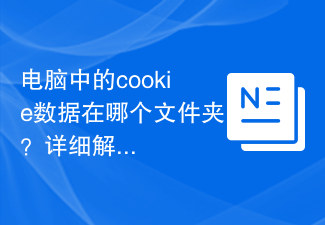 电脑中的cookie数据在哪个文件夹?详细解读Jan 19, 2024 am 10:19 AM
电脑中的cookie数据在哪个文件夹?详细解读Jan 19, 2024 am 10:19 AM随着互联网的不断发展,人们越来越离不开浏览器。而在浏览器中,大家都会或多或少用到cookie这个东西。然而,很多人并不知道cookie数据在哪个文件夹中,今天就来详细解读一下。首先,我们需要了解cookie是什么。简单来说,cookie是由浏览器存储的一段文本信息,用于保存用户在浏览器中的一些个人设置或者记录用户的历史操作等等。当用户再次打开同一个网站时,c
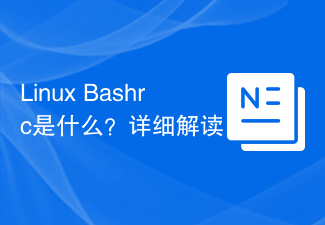 Linux Bashrc是什么?详细解读Mar 20, 2024 pm 09:18 PM
Linux Bashrc是什么?详细解读Mar 20, 2024 pm 09:18 PMLinuxBashrc是Linux系统中的一个配置文件,用于设置用户的Bash(BourneAgainShell)环境。Bashrc文件存储了用户登录时所需的环境变量、启动脚本等信息,可以定制化用户的Shell环境。在Linux系统中,每个用户都有一个对应的Bashrc文件,位于用户的家目录下的隐藏文件夹中。Bashrc文件的作用主要有以下几点:设置环
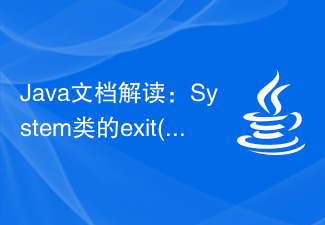 Java文档解读:System类的exit()方法用法解析Nov 03, 2023 pm 03:27 PM
Java文档解读:System类的exit()方法用法解析Nov 03, 2023 pm 03:27 PMJava文档解读:System类的exit()方法用法解析,需要具体代码示例System类是Java中的一个重要类,它提供了许多与系统相关的功能和方法。其中,exit()方法是System类中的一个常用方法,用于终止当前正在运行的Java虚拟机。在本文中,我们将对exit()方法的用法进行解析,并给出具体的代码示例。exit()方法的定义如下:public
 解读国债 RWA 项目现状与六大趋势Mar 24, 2024 am 09:01 AM
解读国债 RWA 项目现状与六大趋势Mar 24, 2024 am 09:01 AM链上资产代币化正在成为一个重要的长期趋势,前景巨大。其中,国债RWA正在成为重要的分支。这一板块在2023年实现了近7倍的增长,在2023年年末经历短暂回落后,又迅速重回上升通道。本篇BingVentures研究文章将讨论国债RWA以及整个RWA版块的现状和重要发展趋势。RWA生态现状在当前市场环境中,DeFi收益率相对较低,同时实际利率上升,这促进了代币化国债等RWA类资产的增长。投资者更倾向于稳定、可预测收益的资产,这一趋势在金融市场和加密货币市场之间寻求平衡的投资者中尤为明显。代币化国债等
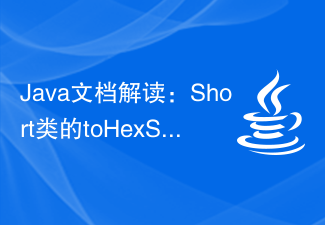 Java文档解读:Short类的toHexString()方法功能解析Nov 03, 2023 am 11:57 AM
Java文档解读:Short类的toHexString()方法功能解析Nov 03, 2023 am 11:57 AMJava文档解读:Short类的toHexString()方法功能解析在Java编程中,我们经常需要进行数值的转换和处理。Short类是Java中的一个包装类,用于处理short类型的数据。其中,Short类提供了一个toHexString()方法,用于将short类型的数据转换为十六进制形式的字符串。本文将对toHexString()方法的功能进行解析,并
 Crypto GPT是什么?为什么说3EX的Crypto GPT是币圈新入口Jul 16, 2024 pm 04:51 PM
Crypto GPT是什么?为什么说3EX的Crypto GPT是币圈新入口Jul 16, 2024 pm 04:51 PMCryptoGPT是什么?为什么说3EX的CryptoGPT是币圈新入口?7月5日消息,3EXAI交易平台正式推出CryptoGPT,这是一个基于AI技术和大数据的创新项目,旨在为全球加密投资者提供全面、智能的信息查询和AI投资建议。CryptoGPT已收录CoinMarketCap排名前200的代币和上百个优质项目方信息,并计划持续扩展。通过CryptoGPT,用户可免费获取详尽的交易咨询报告和AI投资建议,实现信息咨询服务到智能策略创建及自动执行交易的全栈式闭环。目前,该服务已免费开放。有需
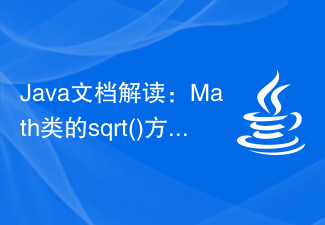 Java文档解读:Math类的sqrt()方法详细说明Nov 04, 2023 pm 03:58 PM
Java文档解读:Math类的sqrt()方法详细说明Nov 04, 2023 pm 03:58 PMJava文档解读:Math类的sqrt()方法详细说明概述:在Java中,Math类是一个包含数学运算函数的工具类。sqrt()方法是其中一个用于计算平方根的函数。本文将详细说明sqrt()方法的用法,并提供具体的代码示例。方法签名:publicstaticdoublesqrt(doublea)方法参数:a-要计算平方根的数值返回值:该方法返回一

Hot AI Tools

Undresser.AI Undress
AI-powered app for creating realistic nude photos

AI Clothes Remover
Online AI tool for removing clothes from photos.

Undress AI Tool
Undress images for free

Clothoff.io
AI clothes remover

AI Hentai Generator
Generate AI Hentai for free.

Hot Article

Hot Tools

Dreamweaver Mac version
Visual web development tools

mPDF
mPDF is a PHP library that can generate PDF files from UTF-8 encoded HTML. The original author, Ian Back, wrote mPDF to output PDF files "on the fly" from his website and handle different languages. It is slower than original scripts like HTML2FPDF and produces larger files when using Unicode fonts, but supports CSS styles etc. and has a lot of enhancements. Supports almost all languages, including RTL (Arabic and Hebrew) and CJK (Chinese, Japanese and Korean). Supports nested block-level elements (such as P, DIV),

PhpStorm Mac version
The latest (2018.2.1) professional PHP integrated development tool

SublimeText3 Chinese version
Chinese version, very easy to use

MinGW - Minimalist GNU for Windows
This project is in the process of being migrated to osdn.net/projects/mingw, you can continue to follow us there. MinGW: A native Windows port of the GNU Compiler Collection (GCC), freely distributable import libraries and header files for building native Windows applications; includes extensions to the MSVC runtime to support C99 functionality. All MinGW software can run on 64-bit Windows platforms.






